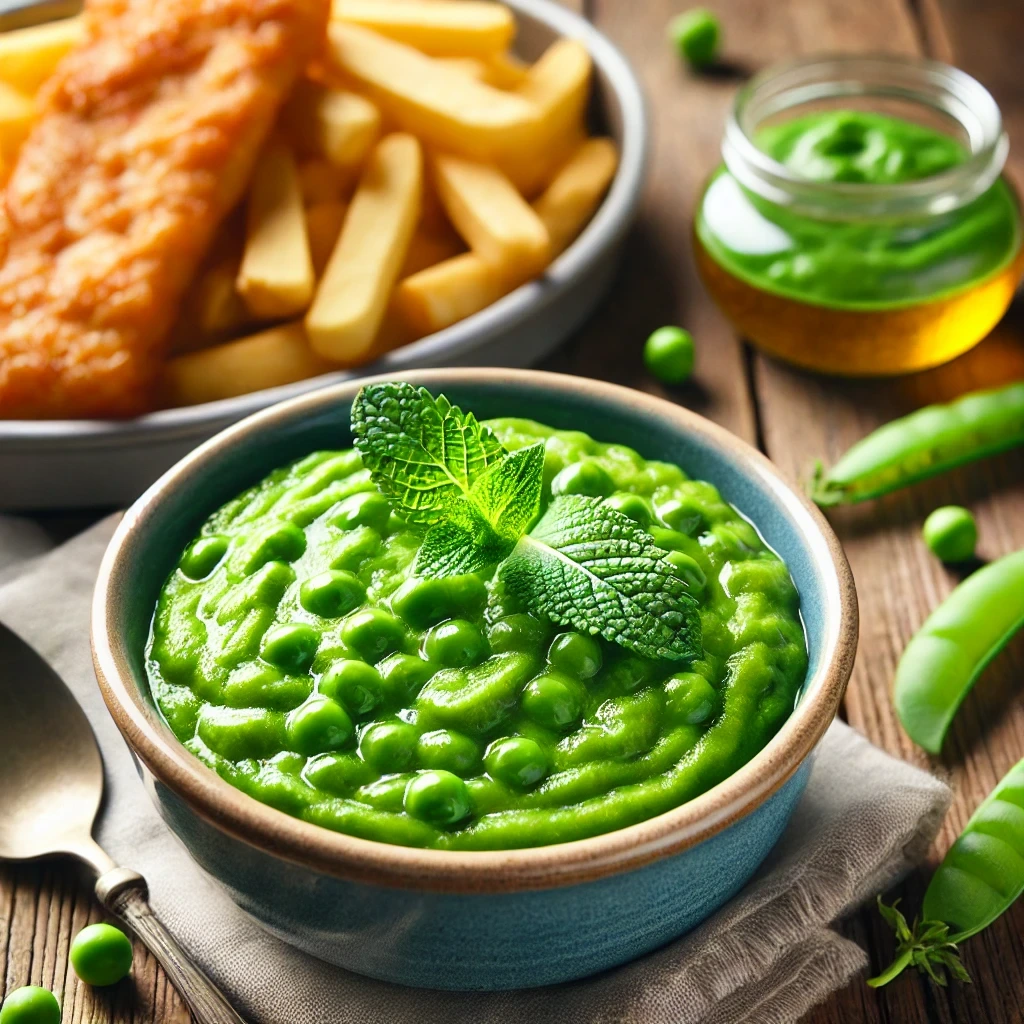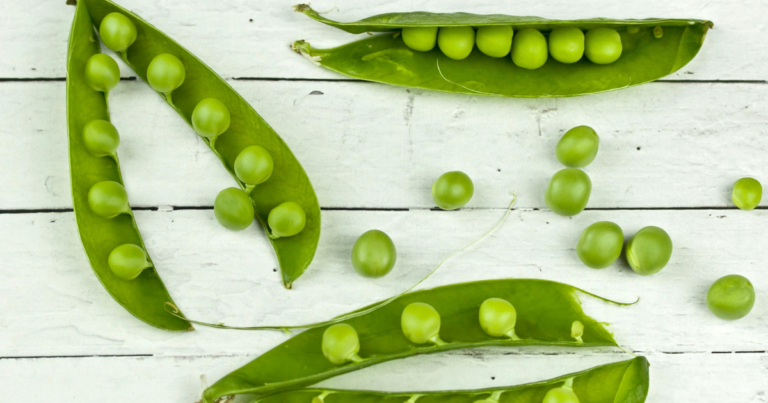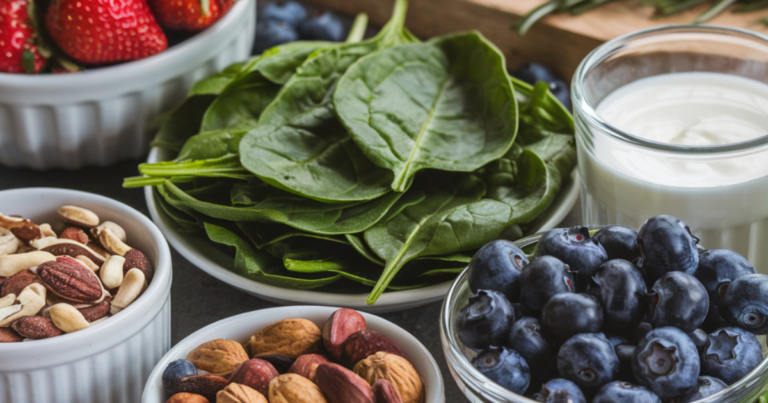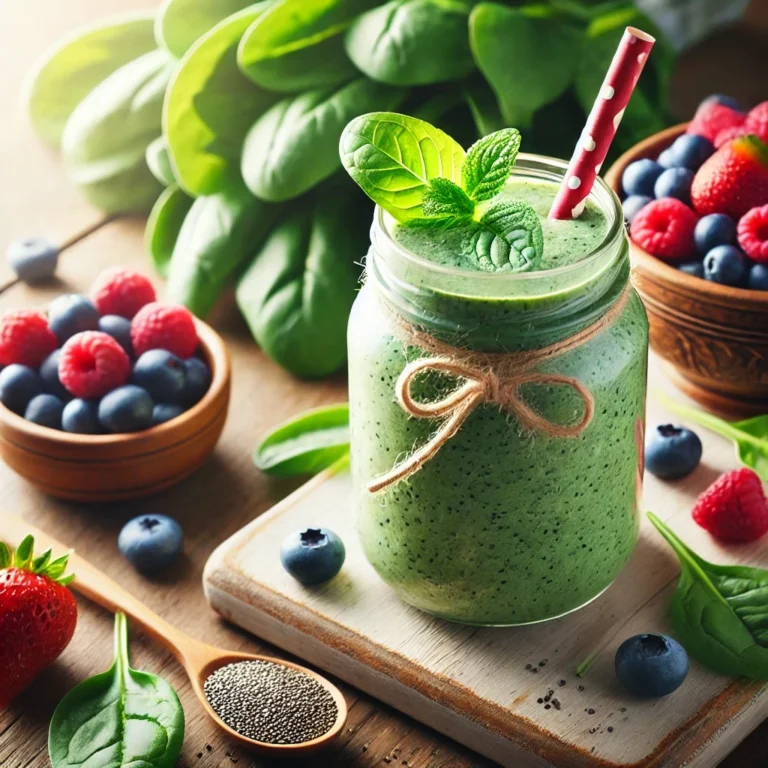Everything You Need to Know About Mushy Green Peas – Recipes, Tips, and Fun Facts
Mushy green peas are a classic and comforting dish that has earned a special place in many kitchens around the world. With their creamy texture and mild flavor, they’re not only a staple in British cuisine but are also growing in popularity internationally. Whether you’re preparing them from scratch or enjoying a pre-made version, this guide will explore everything you need to know about mushy green peas—from their nutritional benefits to preparation methods, and much more. Let’s dive into the world of this humble yet delicious dish!
Nutritional Value
Mushy green peas are not only delicious but also a powerhouse of nutrition. They are packed with essential vitamins, minerals, and dietary fiber, making them a great choice for anyone looking to maintain a healthy diet.
One of the standout features of mushy green peas is their high fiber content, which supports digestive health and helps maintain stable blood sugar levels. They’re also a rich source of plant-based protein, making them an excellent option for vegetarians and vegans.
These peas are loaded with vitamins, particularly Vitamin C, which boosts immunity, and Vitamin K, which supports bone health. Additionally, they contain significant amounts of iron and folate, crucial for energy production and red blood cell formation.
Despite their creamy texture when prepared, mushy green peas are naturally low in fat and calories. This makes them a guilt-free addition to meals, especially for those watching their calorie intake.
Key Nutritional Highlights of Mushy Green Peas (per 100g):
- Calories: Approximately 80 kcal
- Protein: 5g
- Fiber: 6g
- Vitamin C: 40% of the Recommended Daily Allowance (RDA)
- Vitamin K: 25% of the RDA
- Iron: 15% of the RDA
Incorporating mushy green peas into your diet not only adds flavor but also contributes to your overall well-being.
Taste and Texture
Mushy green peas are known for their distinctive combination of sweetness and creaminess, making them a favorite in both traditional and contemporary dishes. Their flavor is subtly sweet, with earthy undertones that add depth to meals without overpowering other ingredients.
The texture of mushy green peas is what truly sets them apart. When properly prepared, they achieve a velvety, smooth consistency that is soft yet retains a hint of graininess. This unique texture is perfect for spreading on toast, using as a side dish, or even incorporating into soups and sauces.
Achieving the ideal taste and texture of mushy green peas often comes down to preparation. Gently simmering or steaming the peas before mashing them preserves their natural sweetness and prevents them from becoming overly watery. For an even creamier texture, some recipes suggest adding a splash of milk or a dollop of butter. A sprinkle of fresh mint or a pinch of salt enhances their flavor profile, bringing out their best qualities.
Whether served plain or with a twist of seasoning, mushy green peas offer a comforting, satisfying experience that pairs well with a variety of dishes.
Preparation Methods
Preparing mushy green peas is simple, and there are several methods to achieve their creamy texture and sweet flavor. Whether you’re using fresh, frozen, or canned peas, the key is to cook them gently to preserve their nutrients and enhance their natural taste.
1. Traditional Boiling Method
- Start by boiling the peas in a small amount of water. Fresh peas will take about 5–8 minutes, while frozen or canned peas may require less time.
- Drain the water, then mash the peas using a potato masher or fork until you reach your desired consistency.
- For extra creaminess, add a splash of milk, a knob of butter, or a drizzle of olive oil.
2. Steaming for Maximum Flavor
- Steaming peas helps retain their nutrients and vibrant green color. Use a steamer basket over boiling water and cook the peas for about 5 minutes.
- After steaming, mash the peas while they’re still hot and season with salt, pepper, and optional herbs like mint.
3. Blending for Ultra-Smooth Peas
- For an extra-smooth texture, use a blender or food processor instead of mashing by hand.
- Blend cooked peas with a small amount of water, vegetable stock, or cream until smooth. This method is perfect for soups and dips.
4. Quick Microwave Method
- Place peas in a microwave-safe dish with a tablespoon of water. Cover and microwave on high for 2–3 minutes.
- Mash them as you would after boiling or steaming and season to taste.
5. Enhancing Flavor
- Add chopped garlic or onions to the peas while cooking for extra depth of flavor.
- Stir in fresh herbs like mint, parsley, or dill for a refreshing twist.
These methods work well for a variety of dishes, whether you’re making a side for a traditional meal or using mushy green peas as a base for creative recipes.
Types of Mushy Green Peas
Mushy green peas come in various forms, each offering unique advantages depending on your preferences and cooking needs. Understanding the differences between these types can help you choose the best option for your recipes.
1. Fresh Mushy Green Peas
Fresh peas are the best choice for those who prioritize flavor and texture. They have a vibrant sweetness and a firm texture that softens perfectly when cooked. However, they require shelling and are only available during specific seasons, making them less convenient for year-round use.
2. Frozen Mushy Green Peas
Frozen peas are a popular and practical choice. They are harvested and flash-frozen at peak ripeness, preserving their nutrients, color, and taste. They’re easy to store, readily available, and quick to cook, making them ideal for creating mushy green peas in no time.
3. Canned Mushy Green Peas
Canned peas are the most convenient option, as they are pre-cooked and ready to use. They have a softer texture, which works well for mashing, but they may lack the vibrant flavor of fresh or frozen peas. To enhance their taste, rinse canned peas thoroughly to remove excess salt and brine before using them in your recipes.
4. Organic Mushy Green Peas
For those who prefer eco-friendly and chemical-free options, organic mushy green peas are a great choice. These peas are grown without synthetic pesticides or fertilizers, ensuring a more natural product. Organic varieties are available in fresh, frozen, and canned forms.
5. Specialty Varieties
Some brands and suppliers offer specialty mushy green peas, such as heirloom varieties or gourmet blends. These may have unique flavors or textures, catering to specific culinary preferences.
Each type of mushy green peas has its own benefits, so your choice will depend on factors like availability, convenience, and the flavor profile you’re looking for.
Best Brands and Products
When it comes to selecting the best mushy green peas, several brands stand out for their quality, flavor, and convenience. Here are some top choices to consider:
Batchelors Original Mushy Peas
A traditional British favorite, Batchelors offers mushy peas with a classic taste and texture. They are pre-cooked and ready to heat and serve, making them a convenient option for authentic mushy peas
Rani Green Peas Whole (Marrowfat Peas)
For those who prefer preparing mushy peas from scratch, Rani Brand provides dried marrowfat peas, known for their suitability in making traditional mushy peas. These all-natural, vegan, and gluten-friendly peas allow for a homemade touch.
Le Sueur Very Young Small Sweet Peas
Known for their tender texture and delicate flavor, Le Sueur peas are a premium choice. While not traditional mushy peas, their quality makes them suitable for creating a refined version of the dish.
Great Value Sweet Peas
A budget-friendly option that doesn’t compromise on taste, Great Value offers sweet peas with a firm texture and pleasant flavor. They are versatile and can be used to make mushy peas conveniently.
Cascadian Farm Organic Sweet Peas
For those seeking organic options, Cascadian Farm provides frozen sweet peas that are harvested at peak ripeness. Their freshness and natural sweetness make them an excellent choice for homemade mushy peas.
When selecting a brand, consider factors such as preparation time, flavor preferences, and whether you prefer a ready-to-eat product or enjoy cooking from scratch. Each of these brands offers a unique take on mushy green peas, catering to different tastes and culinary needs.
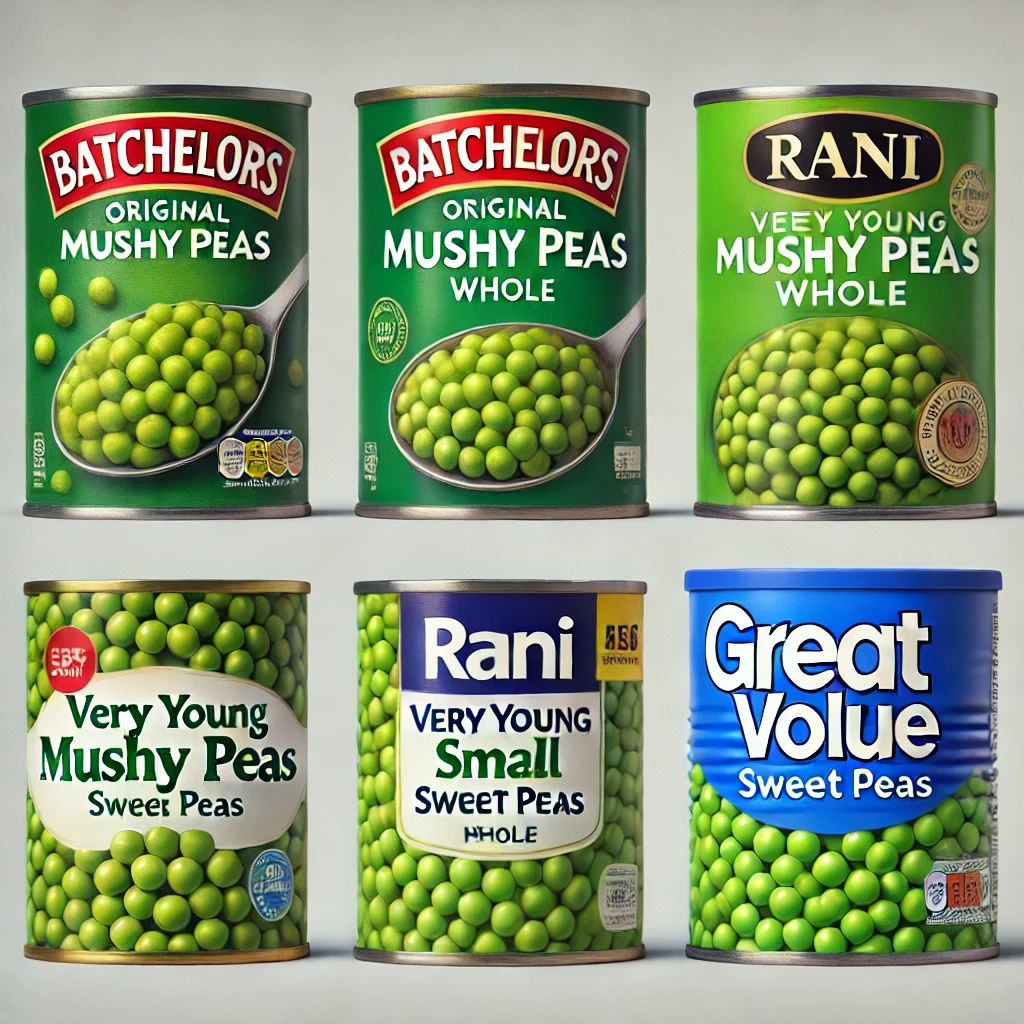
Pairing Ideas
Mushy green peas are incredibly versatile and can be paired with a wide variety of dishes to create balanced and flavorful meals. Their creamy texture and subtle sweetness make them the perfect complement to both traditional and modern recipes.
1. Classic Pairings
- Fish and Chips: Mushy green peas are a quintessential side dish for fish and chips, adding a creamy and refreshing element to the crispy fried fish and chips.
- Meat Pies: Serve mushy green peas alongside meat pies or savory pastries for a comforting and hearty meal.
- Roast Dinners: Add a side of mushy green peas to roast chicken, beef, or lamb to enhance the overall flavor and nutrition of the meal.
2. Vegetarian Pairings
- Vegetable Stir-Fry: Use mushy green peas as a base or side for stir-fried vegetables to bring a rich and creamy texture to the dish.
- Grain Bowls: Combine mushy green peas with quinoa, brown rice, or couscous, along with roasted vegetables and a light dressing, for a wholesome vegetarian bowl.
- Toasts and Bruschetta: Spread mushy green peas on toasted bread and top with feta, mint, or cherry tomatoes for a simple yet elegant appetizer.
3. Gourmet Pairings
- Seafood Delights: Pair mushy green peas with scallops, shrimp, or seared salmon to balance the richness of the seafood with the peas’ delicate sweetness.
- Risottos and Pastas: Stir mushy green peas into risottos or creamy pasta dishes for added flavor, texture, and visual appeal.
- Appetizer Platters: Serve mushy green peas as a dip or spread alongside crackers, crudités, and cheeses for an elevated snack platter.
4. Fusion Ideas
- Pea Tacos: Use mushy green peas as a topping or filling for tacos, blending them with spices and herbs for a unique twist.
- Asian-Inspired Meals: Pair mushy green peas with dishes like fried rice, dumplings, or spring rolls for a touch of creaminess and color.
- Mediterranean Mezze: Incorporate mushy green peas into a mezze platter with hummus, baba ganoush, and flatbreads.
These pairing ideas show how versatile mushy green peas can be, whether you’re creating a comforting classic or experimenting with global flavors.
Storage Tips
Proper storage of mushy green peas is essential to maintain their flavor, texture, and nutritional value. Whether you’re dealing with fresh, frozen, or prepared mushy green peas, following these tips will help ensure they stay in top condition.
1. Fresh Mushy Green Peas
- Refrigeration: If you’ve made mushy green peas from fresh peas, store them in an airtight container in the refrigerator. They should be consumed within 2–3 days to maintain their freshness.
- Freezing: To extend their shelf life, freeze the mushy peas. Let them cool completely, then portion them into freezer-safe bags or containers. Frozen mushy green peas can last up to 3 months.
2. Frozen Mushy Green Peas
- In the Freezer: Always keep store-bought frozen peas in their original packaging or transfer them to a resealable freezer bag. Avoid repeated thawing and refreezing, as this can degrade their quality.
- After Cooking: If you’ve prepared mushy green peas using frozen peas, you can refrigerate them for up to 3 days or refreeze them for longer storage.
3. Canned Mushy Green Peas
- Unopened Cans: Store canned peas in a cool, dry place, away from direct sunlight. Check the expiration date on the can for maximum freshness.
- After Opening: Transfer unused peas from an opened can into an airtight container and refrigerate. Use them within 1–2 days. Prepared mushy green peas from canned peas can be frozen for up to 3 months.
4. Reheating Tips
- When reheating mushy green peas, add a small amount of water or broth to restore their creamy consistency. Heat gently in a saucepan or microwave, stirring occasionally to prevent drying out.
5. Avoiding Spoilage
- Always store mushy green peas in clean, airtight containers to prevent contamination.
- Label containers with the storage date to keep track of freshness.
Sustainability and Sourcing
Mushy green peas are not only delicious and versatile but can also be a sustainable food choice. Understanding how to source and consume them responsibly can help reduce environmental impact while supporting ethical farming practices.
1. Environmental Benefits of Pea Cultivation
- Low Water Usage: Peas require less water to grow compared to many other crops, making them a water-efficient choice.
- Nitrogen Fixation: As legumes, peas naturally improve soil fertility by fixing nitrogen, reducing the need for synthetic fertilizers.
- Low Carbon Footprint: Compared to animal-based foods, growing peas generates a significantly lower carbon footprint, contributing to a more sustainable food system.
2. Choosing Sustainable Options
- Organic Mushy Green Peas: Opt for peas labeled as organic, which are grown without synthetic pesticides or fertilizers. Organic farming promotes healthier ecosystems and reduces chemical runoff.
- Local and Seasonal Peas: Purchasing fresh peas from local farmers or during their natural growing season helps reduce transportation emissions and supports local agriculture.
- Fair Trade Products: Look for fair trade certifications when buying imported peas to ensure fair wages and ethical labor practices for farmers.
3. Reducing Waste
- Smart Storage: Store mushy green peas properly to prevent spoilage and minimize food waste. Use freezing techniques for long-term preservation.
- Compost Pea Shells: If using fresh peas, compost the shells to enrich your garden soil instead of discarding them in the trash.
4. Sustainable Packaging
- Choose products that use recyclable or biodegradable packaging. Many brands now offer peas in eco-friendly materials to reduce plastic waste.
5. Supporting Sustainable Brands
- Several companies prioritize sustainability by sourcing peas responsibly and supporting regenerative agriculture. Research brands and products to find those aligning with your values.
By choosing sustainably sourced mushy green peas and adopting eco-friendly practices, you can enjoy this versatile food while contributing to a healthier planet.
Cultural Significance
Mushy green peas hold a special place in the culinary traditions of various cultures, particularly in the United Kingdom, where they are a beloved staple. Their history, versatility, and enduring popularity make them a fascinating subject to explore.
1. A British Classic
Mushy green peas are an iconic part of British cuisine. They are a traditional accompaniment to fish and chips, often served in a small bowl or directly alongside the main dish. Their creamy texture and mild flavor balance the richness of fried foods, making them a quintessential side in British pubs and homes.
2. Regional Variations
- England: In Northern England, mushy peas are often paired with savory meat pies and are a key component of pie and pea suppers.
- Scotland: In Scotland, mushy peas are sometimes served alongside haggis or added to hearty stews, showcasing their adaptability to local flavors.
- Ireland: In Irish cuisine, mushy green peas appear in both traditional and modern recipes, symbolizing comfort and sustenance.
3. Historical Roots
The tradition of making mushy green peas dates back to medieval times when dried marrowfat peas were a staple for their long shelf life and affordability. They were commonly soaked, cooked, and mashed into a simple yet nutritious dish.
4. A Global Twist
While most associated with British cuisine, mushy green peas have gained international recognition. Chefs worldwide have begun incorporating them into fusion dishes, adding herbs, spices, and other ingredients to create innovative takes on the classic recipe.
5. Symbol of Comfort Food
For many, mushy green peas are a nostalgic comfort food, evoking memories of family meals and communal gatherings. Their simplicity and heartiness make them a dish that transcends generations.
Health Considerations
Mushy green peas are a nutritious addition to many diets, but it’s essential to consider certain health aspects to ensure they align with your dietary needs and preferences. Here’s a breakdown of the potential health benefits and considerations related to this classic dish.
1. Nutritional Benefits
- Rich in Fiber: Mushy green peas are an excellent source of dietary fiber, which supports healthy digestion and can help manage cholesterol levels.
- Good Source of Protein: They contain plant-based protein, making them a valuable food for vegetarians and vegans.
- Packed with Vitamins and Minerals: Mushy green peas provide essential nutrients like Vitamin C, Vitamin K, and iron, supporting overall health and immunity.
2. Low-Calorie and Low-Fat
Mushy green peas are naturally low in calories and fat, making them a great choice for those aiming to maintain a healthy weight or reduce fat intake.
3. Vegan and Gluten-Free
As long as no animal-derived or gluten-containing ingredients are added, mushy green peas are suitable for vegan and gluten-free diets. Always check the ingredient labels if buying pre-made versions.
4. Sodium Levels
- Homemade vs. Store-Bought: While homemade mushy green peas can be seasoned to taste with minimal salt, some store-bought versions may contain higher sodium levels. If you are monitoring your sodium intake, opt for low-sodium varieties or make them from scratch.
5. Digestive Sensitivity
- Gas and Bloating: Some individuals may experience gas or bloating after consuming mushy green peas due to their fiber and natural sugar content. Soaking dried peas thoroughly before cooking can help reduce this effect.
- Portion Control: Eating moderate portions can also minimize digestive discomfort while reaping the benefits of their fiber content.
6. Allergy Considerations
- Pea Allergies: Though rare, some individuals may have a legume allergy that includes peas. If you have known sensitivities, consult your doctor before consuming them.
7. Balance in Diet
While mushy green peas are nutritious, they should be part of a varied diet that includes a wide range of fruits, vegetables, whole grains, and proteins to ensure optimal health.
Buying Guide
When shopping for mushy green peas, knowing what to look for ensures you get the best quality and value for your money. Whether you prefer fresh, frozen, canned, or pre-made mushy peas, this guide will help you make informed decisions.
1. Fresh Mushy Green Peas Ingredients
- Marrowfat Peas: If making mushy green peas from scratch, choose dried marrowfat peas, as these are traditionally used for their starchy texture and rich flavor.
- Quality Indicators: Look for peas that are uniform in size, free from cracks, and have a vibrant color.
- Local Produce: Visit farmers’ markets to find fresh peas during their growing season, supporting local agriculture and ensuring freshness.
2. Frozen Mushy Green Peas
- Convenience: Frozen peas are an excellent option for quick preparation. Check the packaging for no added preservatives or artificial flavorings.
- Storage: Ensure the bag is properly sealed, and the peas are free from clumps, which can indicate thawing and refreezing.
3. Canned Mushy Green Peas
- Low-Sodium Options: Many canned peas are high in sodium. Look for options labeled “low sodium” or “no added salt” for a healthier choice.
- Check Ingredients: Choose products with minimal ingredients—ideally just peas, water, and a bit of salt.
- BPA-Free Packaging: Opt for brands that use BPA-free cans to reduce potential exposure to harmful chemicals.
4. Pre-Made Mushy Green Peas
- Ready-to-Serve Products: For convenience, some brands offer pre-cooked mushy green peas in jars, cans, or frozen packets.
- Flavor Variations: Some pre-made options may include added herbs or seasonings like mint. Choose flavors that complement your planned dishes.
- Reputable Brands: Look for trusted brands known for quality and taste, as discussed in the “Best Brands and Products” section.
5. Organic and Ethical Choices
- Organic Peas: Opt for certified organic products to avoid exposure to synthetic pesticides and fertilizers.
- Fair Trade: Support ethical farming practices by choosing fair trade-labeled products, especially for imported peas.
6. Cost Considerations
- Budget-Friendly Options: Dried peas are often the most affordable choice for making mushy green peas at home. Frozen and canned options provide convenience at a slightly higher price.
- Bulk Purchases: Consider buying in bulk if you frequently prepare mushy green peas. This can save money and reduce packaging waste.
7. Where to Buy
- Grocery Stores: Major supermarkets often carry a variety of options, including fresh, frozen, canned, and pre-made mushy green peas.
- Online Retailers: Websites like Amazon or specialty food stores offer a wide selection, including organic and imported varieties.
- Farmers’ Markets: For the freshest options, visit local markets during pea season.
Fun Facts and Trivia
Mushy green peas are more than just a beloved side dish—they have a fascinating history and some surprising trivia associated with them. Here are some fun facts to make you appreciate this humble food even more:
1. The Origin of Mushy Green Peas
- The tradition of cooking peas into a soft, creamy dish dates back to medieval England, where dried peas were a staple for their affordability and long shelf life.
- Marrowfat peas, the key ingredient in mushy green peas, are a specific variety of pea left to mature on the vine, giving them their starchy texture and distinctive flavor.
2. A British Institution
- Mushy green peas are an iconic part of British fish and chip culture, often served as a “third element” alongside fried fish and crispy chips.
- They’re also a must-have at pie and mash shops, where they complement the savory flavors of traditional British meat pies.
3. Green and Blue?
- In the 1970s, some vendors in Northern England added artificial coloring to make mushy peas an even brighter shade of green—or even blue! This quirky practice earned them the nickname “blue peas” in some areas.
4. International Popularity
- While mushy green peas are quintessentially British, their popularity has spread internationally. Many chefs incorporate them into modern dishes, including pasta sauces, risottos, and gourmet toast toppings.
5. Packed with Symbolism
- In the Victorian era, peas symbolized prosperity and fertility. Serving them at celebratory meals, like weddings or harvest feasts, was common.
- Today, they’re considered a symbol of comfort food, often evoking nostalgia and a sense of home.
6. A Guinness World Record
- The largest serving of mushy peas ever made weighed over 900 kilograms (nearly 2,000 pounds). This record-breaking effort was achieved in the UK, showcasing just how cherished this dish is.
7. The Mighty Pea Plant
- Peas are one of the oldest cultivated crops, with evidence of their cultivation dating back to 9,000 years ago in the Middle East. The mushy green peas we enjoy today carry a rich agricultural legacy.
8. A Healthy Classic
- Mushy green peas were promoted as a wartime staple in the UK due to their affordability, nutritional value, and ability to stretch limited rations. They became a symbol of resilience during tough times.
Common Questions About Mushy Green Peas
Mushy green peas are a popular dish with a long history and plenty of versatility. Here are answers to some of the most frequently asked questions about them:
1. What Are Mushy Green Peas?
Mushy green peas are traditionally made by cooking marrowfat peas until they become soft and creamy. They are a classic British side dish often served with fish and chips, pies, and other hearty meals.
2. Are Mushy Green Peas Healthy?
Yes, mushy green peas are a nutritious choice. They are rich in fiber, protein, and essential vitamins such as Vitamin C and B vitamins. Their low calorie and fat content make them a great addition to a balanced diet.
3. Can I Make Mushy Green Peas with Regular Green Peas?
While traditional mushy green peas are made with marrowfat peas, you can use regular green peas as an alternative. Simply cook them until soft and mash them with a little butter and seasoning for a similar texture and taste.
4. How Do You Prepare Mushy Green Peas from Scratch?
To make mushy green peas from scratch:
- Soak dried marrowfat peas overnight in water with a pinch of baking soda.
- Drain and rinse them, then simmer in fresh water until tender.
- Mash the peas to your desired consistency, adding salt, butter, or mint as preferred.
5. Can Mushy Green Peas Be Frozen?
Yes, mushy green peas can be frozen. Allow them to cool completely, then portion them into airtight containers or freezer bags. They can be stored in the freezer for up to 3 months. Reheat gently to enjoy them again.
6. Are Mushy Green Peas Suitable for Vegans?
Yes, mushy green peas are naturally vegan, provided no butter or non-vegan ingredients are added. You can enhance their flavor with olive oil, plant-based butter, or herbs for a vegan-friendly version.
7. Do Mushy Green Peas Have Gluten?
Mushy green peas are naturally gluten-free. However, check the labels if you are purchasing canned or pre-prepared versions to ensure no gluten-containing ingredients have been added.
8. What Can I Serve with Mushy Green Peas?
Mushy green peas pair well with fish and chips, meat pies, roasted meats, and vegetarian dishes like grain bowls or risottos. They are also a great topping for toast or crackers.
Conclusion
Mushy green peas are much more than a simple side dish—they’re a timeless classic with a rich history, incredible versatility, and undeniable charm. From their nutritional benefits to their cultural significance and innovative uses in modern cuisine, they have earned their place on plates around the world.
Whether you’re savoring them alongside fish and chips, experimenting with creative pairings, or simply enjoying their creamy, comforting texture, mushy green peas bring a touch of nostalgia and heartiness to any meal. By choosing high-quality ingredients, exploring new preparation methods, and storing them properly, you can enjoy this iconic dish at its best.
With their delightful taste, health benefits, and deep roots in culinary tradition, mushy green peas are a true testament to how simple ingredients can create extraordinary experiences. So next time you reach for a plate of mushy green peas, remember—you’re not just eating a dish; you’re celebrating a piece of history and culture.

